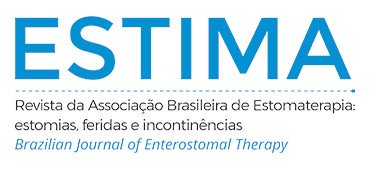NURSING TELECONSULTATION FOR PEOPLE WITH SPINAL CORD INJURY: NURSES’ OPINION ON THE MAIN GUIDELINES
Abstract
Objective: to identify the opinion of nurses on the main topics to be addressed in the nursing teleconsultation of a telerehabilitation program for spinal cord injuries. Methods: descriptive and exploratory study, carried out with experienced nurses in the rehabilitation of people with spinal cord injuries in a network of rehabilitation hospitals. 70 nurses participated in the study. The data were collected through self-administered questionnaires built on the Google Forms® platform and organized in an Excel® spreadsheet. A descriptive statistical analysis of objective responses and a categorical content analysis of discursive responses were performed. Results: Nurses considered it important to accompany people with spinal cord injuries in the transition from care to home and to provide guidance through social networks, telephones, and/or applications. It was found that the main topics to be addressed in the nursing teleconsultation in a telerehabilitation service are skin care and bladder and bowel reeducation. Conclusions: The nursing teleconsultation allows the exchange of information between the nurse of a specialized rehabilitation service and the person with a spinal cord injury in their home environment, encouraging learning and enabling the person’s co-participation and proactivity in managing their self-care.
Downloads
Metrics
References
Ding W, Hu S, Wang P, Kang H, Peng R, Dong Y, Li F. Spinal Cord Injury: The Global Incidence, Prevalence, and Disability from the Global Burden of Disease Study 2019. Spine (Phila Pa 1976) 2022;47(21):1532-1540. https://doi.org/10.1097/brs.0000000000004417
Zhang Y, Al Mamun A, Yuan Y, Lu Q, Xiong J, Yang S, Wu C, Wu Y, Wang J. Acute spinal cord injury: Pathophysiology and pharmacological intervention (Review). Mol Med Rep. 2021;23(6):417. https://doi.org/10.3892/mmr.2021.12056
Ghibaudi M, Boido M, Green D, Signorino E, Berto GE, Pourshayesteh S, Singh A, Di Cunto F, Dalmay T, Vercelli A. miR-7b-3p Exerts a Dual Role after Spinal Cord Injury, by Supporting Plasticity and Neuroprotection at Cortical Level. Front Mol Biosci. 2021;8:618869. https://doi.org/10.3389%2Ffmolb.2021.618869
Instituto Brasileiro de Geografia e Estatística (IBGE). Diretoria de Pesquisas, Coordenação de Pesquisas por Amostra de Domicílios. Pesquisa Nacional por Amostra de Domicílios Contínua 2022. [cited em 2023 aug 01]. Available at: https://biblioteca.ibge.gov.br/visualizacao/livros/liv102013_informativo.pdf
Faleiros F, Marcossi M, Ribeiro O, Tholl A, Freitas G, Ribeirto M. Epidemiological profile of spinal cord injury in Brazil. J Spinal Cord Med. 2022;46(1):75-82. https://doi.org/10.1080/10790268.2021.1947679
Ruiz AGB, Barreto MS, Peruzzo HE, Schoeller SD, Decesaro MN; Marco SS. Atuação da rede de apoio às pessoas com lesão medular. Rev. Min. Enferm. 2018; 22,e-1116,1-9. [cited em 2023 aug 01] Available at: https://pesquisa.bvsalud.org/portal/resource/pt/biblio-912103
Mari KLS, Siqueira TCS, Moura MC, Salicio MA, Salicio VMM. Técnicas fisioterapêuticas utilizadas na reabilitação de pacientes com lesão medular: estudo de revisão. Connection line-revista eletrônica do univag 2019;20. https://doi.org/10.18312/connectionline.v0i20.1244
Kryger MA, Crytzer TM, Fairman A, Quinby EJ, Karavolis M, Pramana G, Setiawan IMA, McKernan GP, Parmanto B, Dicianno BE. The Effect of the Interactive Mobile Health and Rehabilitation System on Health and Psychosocial Outcomes in Spinal Cord Injury: Randomized Controlled Trial. J Med Internet Res. 2019;21(8):e14305. https://doi.org/10.2196/14305
Toffoletto MC, Tello JDA. Telenursing in care, education and management in Latin America and the Caribbean: an integrative review. Rev Bras Enferm. 2020;73 Suppl 5(Suppl 5):e20190317. https://doi.org/10.1590/0034-7167-2019-0317
Porto Alegre. Secretaria Municipal da Saúde. Diretoria Geral de Atenção Primária à Saúde; Universidade Federal do Rido Grande do Sul. Programa de Pós-Graduação em Epidemiologia. Telessaúde RS (Telessaúde RS-UFRGS). Manual de teleconsulta na APS. Porto Alegre, jun. 2020. [cited em 2023 aug 01]. Available at: https://www.ufrgs.br/telessauders/documentos/Manual_teleconsultas.pdf.
Solomon RM, Dhakal R, Halpin SJ, Hariharan R, O’Connor RJ, Allsop M, Sivan M. Telerehabilitation for individuals with spinal cord injury in low-and middle-income countries: a systematic review of the literature. Spinal Cord. 2022;60(5):395-403. https://doi.org/10.1038/s41393-022-00797-8
Sampaio RC, Lycarião D. Análise de conteúdo categorial: manual de aplicação. Brasília: Enap, 2021;155 p.
Faleiros F, Käppler C, Pontes FAR, Silva SSC, Goes FSN, Cucick CD. Uso de questionário online e divulgação virtual como estratégia de coleta de dados em estudos científicos. Texto contexto – enferm. 2016; [cited 2019 mar 27]; 25(4), e3880014.https://doi.org/10.1590/0104-07072016003880014.
Mineiro M. Pesquisa de survey e amostragem: aportes teóricos elementares. Revista de Estudos em Educação e Diversidade. 2020 out/dez; [cited 2022 aug 28]; 1(2);284-306. https://doi.org/10.22481/reed.v1i2.7677
Rodrigues LP, Rezende MP, Silva AMB, Ferreira LA, Goulart BF. Conhecimento e adesão da equipe de enfermagem aos equipamentos de proteção individual. REME - Rev Min Enferm. 2019;23:e-1225. [cited 2023 aug 01] Available at: https://pesquisa.bvsalud.org/portal/resource/pt/biblio-1051109
Machado MH. Perfil da enfermagem no Brasil. Rio de Janeiro: COFEn, Fiocruz; 2017. [cited 2023 aug 01]. Available at: http://biblioteca.cofen.gov.br/wp-content/uploads/2019/05/relatoriofinal.pdf.
Irgens I, Rekand T, Arora R, Liu N, Marshall R, Biering-Sørensen F et al. Telehealth for people with spinal cord injury: a narrative review. Spinal Cord. 2018;56:643-655. https://doi.org/10.1038/s41393-017-0033-3
Attabib N, Kurban D, Cheng CL, Rivers CS, Bailey CS, Christie S et al. Factors Associated with Recovery in Motor Strength, Walking Ability, and Intestinal and Bexiga Function after Traumatic Cauda Equina Injury. J Neurotrauma. 2021;38(3):322-329. https://doi.org/10.1089/neu.2020.7303
Hug K, Stumm C, Debecker I, Fellinghauer CS, Peter C, Hund-Georgiadis M. Self-Efficacy and Pressure Ulcer Prevention After Spinal Cord Injury—Results from a Nationwide Community Survey in Switzerland. 2018;10(6):573-586. https://doi.org/10.1016/j.pmrj.2017.11.017
Kim J, Lim S, Yun J, Kim DH. Telerehabilitation needs: a bidirectional survey of health professionals and individuals with spinal cord injury in South Korea. Telemed J E Health. 2012;18(9):713-7. https://doi.org/10.1089%2Ftmj.2011.0275
Silva JP, Crepaldi MA, Bousfield AB, Silva B. Representações Sociais e Doenças Crônicas no Contexto Familiar: Revisão Integrativa. Revista Psicologia e Saúde. 2021;13(2):125-140. https://doi.org/10.20435/pssa.v13i2.964
Braaf S, Ameratunga S, Nunn A, Christie N, Teague W, Judson R et al. Patient-identified information and communication needs in the context of major trauma. BMC health services research. 2018;18(1):1-13. https://doi.org/10.1186/s12913-018-2971-7
Aaby A, Ravn SL, Kasch H, Andersen TE. Structure and conceptualization of acceptance: a split-sample exploratory and confirmatory factor analysis approach to investigate the multidimensionality of acceptance of spinal cord injury. J Rehabil Med. 2021 [cited 2022 aug 28];53(10): 2829. https://doi.org/10.2340/16501977-2876
Musco S, Bazzocchi G, Martellucci J, Amato MP, Manassero A, Putignano D et al. Treatments in neurogenic bowel dysfunctions: evidence reviews and clinical recommendations in adults. Eur J Phys Rehabil Med. 2020;56(6):741-755. https://doi.org/10.23736/s1973-9087.20.06412-6
Conti A, Dimonte V, Rizzi A, Clari M, Mozzone S, Garrino L et al. Barriers and facilitators of education provided during rehabilitation of people with spinal cord injuries: A qualitative description. PloS one. 2020;15(10):e0240600. https://doi.org/10.1371/journal.pone.0240600
Downloads
Published
How to Cite
Issue
Section
License
Copyright (c) 2023 Lisabel Tabari, Ivone Kamada, Soraia Assad Nasbine Rabeh, Paula Cristina Nogueira

This work is licensed under a Creative Commons Attribution 4.0 International License.

























